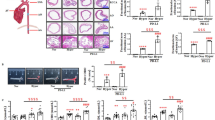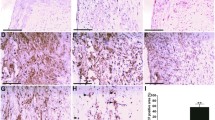Abstract
COX-2 contributes to local inflammation in atherosclerotic lesions. Regulatory T cells (Tregs) enhance the stability of atherosclerotic plaques. The aim of this study was to detect the potential relationship between Tregs and COX-2 in vulnerable plaques. Thirty ApoE −/− mice were fed a high-fat diet, and a silastic perivascular collar was placed around the right common carotid artery to induce vulnerable plaques. Eight weeks after collar placement, the mice were divided randomly into three groups: control, PBS, and Treg groups. Four weeks later, the right common carotid arteries were collected to detect the expression of COX-2. The results showed that Tregs significantly suppressed the expression of COX-2 in vulnerable plaques. In an in vitro experiment, RAW264.7 cells were divided randomly into three groups, which were precultured without T cells or with CD4 + CD25- T cells or Tregs for 48 h with an anti-CD3 antibody; then the cells were stimulated with LPS for 24 h. The RAW264.7 cells were harvested for RT-PCR and western blot assays and the results showed that Tregs downregulated COX-2 expression in RAW264.7 cells. Therefore, Tregs inhibited the expression of COX-2 in vulnerable plaques and macrophages, and COX-2 inhibition may be an important effect of Tregs that results in atherosclerotic plaque stabilization.


Similar content being viewed by others
References
Libby P (2012) Inflammation in atherosclerosis. Arterioscler Thromb Vasc Biol 32(9):2045–2051
Yang T, Sun D, Huang YG, Smart A, Briggs JP, Schnermann JB (1999) Differential regulation of COX-2 expression in the kidney by lipopolysaccharide: role of CD14. Am J Physiol 277(1 Pt 2):F10–16
Zahner G, Schaper M, Panzer U, Kluger M, Stahl RA, Thaiss F, Schneider A (2009) Prostaglandin EP2 and EP4 receptors modulate expression of the chemokine CCL2 (MCP-1) in response to LPS-induced renal glomerular inflammation. Biochem J 422(3):563–570
Narasimha AJ, Watanabe J, Ishikawa TO, Priceman SJ, Wu L, Herschman HR, Reddy ST (2010) Absence of myeloid COX-2 attenuates acute inflammation but does not influence development of atherosclerosis in apolipoprotein E null mice. Arterioscler Thromb Vasc Biol 30(2):260–268
Kuge Y, Takai N, Ishino S, Temma T, Shiomi M, Saji H (2007) Distribution profiles of membrane Type-1 matrix metalloproteinase (MT1-MMP), matrix metalloproteinase-2 (MMP-2) and cyclooxygenase-2 (COX-2) in rabbit atherosclerosis: comparison with plaque instability analysis. Biol Pharm Bull 30(9):1634–1640
Sakaguchi S (2005) Naturally arising Foxp3-expressing CD25+CD4+ regulatory T cells in immunological tolerance to self and non-self. Nat Immunol 6:345–352
Mor A, Planer D, Luboshits G, Afek A, Metzger S, Chajek-Shaul T, Keren G, George J (2007) Role of naturally occurring CD4+ CD25+ regulatory T cells in experimental atherosclerosis. Arterioscler Thromb Vasc Biol 27(4):893–900
Meng X, Li W, Yang J, Zhang K, Qin W, An G, Gao F, Wang Y, Zhang C, Zhang Y (2013) Regulatory T cells prevent plaque disruption in apolipoprotein E-knockout mice. Int J Cardiol 168(3):2684–2692
Cheng C, Noordeloos AM, Jeney V, Soares MP, Moll F, Pasterkamp G, Serruys PW, Duckers HJ (2009) Heme oxygenase 1 determines atherosclerotic lesion progression into a vulnerable plaque. Circulation 119:3017–3027
Yand JM, Dong M, Meng X, Zhao YX, Yang XY, Liu XL, Hao PP, Li JJ, Wang XP, Zhang K, Gao F, Zhao XQ, Zhang MX, Zhang Y, Zhang C (2013) Angiotensin-(1–7) dose-dependently inhibits atherosclerotic lesion formation and enhances plaque stability by targeting vascular cells. Arterioscler Thromb Vasc Biol 33(8):1978–1985
Hui Y, Ricciotti E, Crichton I, Yu Z, Wang D, Stubbe J, Wang M, Puré E, FitzGerald GA (2010) Targeted deletions of cyclooxygenase-2 and atherogenesis in mice. Circulation 121(24):2654–2660
Kim CK, Cho DH, Lee KS, Lee DK, Park CW, Kim WG, Lee SJ, Ha KS, Goo Taeg O, Kwon YG, Kim YM (2012) Ginseng berry extract prevents atherogenesis via anti-inflammatory action by upregulating phase ii gene expression. Evid Based Complement Alternat Med 2012:490301
Cipollone F, Prontera C, Pini B, Marini M, Fazia M, De Cesare D, Iezzi A, Ucchino S, Boccoli G, Saba V, Chiarelli F, Cuccurullo F, Mezzetti A (2001) Overexpression of functionally coupled cyclooxygenase-2 and prostaglandin E synthase in symptomatic atherosclerotic plaques as a basis of prostaglandin E(2)-dependent plaque instability. Circulation 104(8):921–927
Dietel B, Cicha I, Voskens CJ, Verhoeven E, Achenbach S, Garlichs CD (2013) Decreased numbers of regulatory T cells are associated with human atherosclerotic lesion vulnerability and inversely correlate with infiltrated mature dendritic cells. Atherosclerosis 230(1):92–99
Erdman SE, Sohn JJ, Rao VP, Nambiar PR, Ge Z, Fox JG, Schauer DB (2005) CD4+CD25+ regulatory lymphocytes induce regression of intestinal tumors in Apc Min/+ mice. Cancer Res 65(10):3998–4004
Browatzki M, Larsen D, Pfeiffer CA, Gehrke SG, Schmidt J, Kranzhofer A, Katus HA, Kranzhofer R (2005) Angiotensin II stimulates matrix metalloproteinase secretion in human vascular smooth muscle cells via nuclear factor-kappaB and activator protein 1 in a redox-sensitive manner. J Vasc Res 42:415–423
Solomon SD, Pfeffer MA, McMurray JJ, Fowler R, Finn P, Levin B, Eagle C, Hawk E, Lechuga M, Zauber AG, Bertagnolli MM, Arber N, Wittes J, APC, and PreSAP Trial Investigators (2006) Effect of celecoxib on cardiovascular events and blood pressure in two trials for the prevention of colorectal adenomas. Circulation 114(10):1028–1035
Jacob S, Laury-Kleintop L, Lanza-Jacoby S (2008) The select cyclooxygenase-2 inhibitor celecoxib reduced the extent of atherosclerosis in ApoE-/- mice. J Surg Res 146(1):135–142
Vidal C, Gómez-Hernández A, Sánchez-Galán E, González A, Ortega L, Gómez-Gerique JA, Tuñón J, Egido J (2007) Licofelone, a balanced inhibitor of cyclooxygenase and 5-lipoxygenase, reduces inflammation in a rabbit model of atherosclerosis. J Pharmacol Exp Ther 320(1):108–116
Bea F, Blessing E, Bennett BJ, Kuo CC, Campbell LA, Kreuzer J, Rosenfeld ME (2003) Chronic inhibition of cyclooxygenase-2 does not alter plaque composition in a mouse model of advanced unstable atherosclerosis. Cardiovasc Res 60(1):198–204
Raval M, Frank PG, Laury-Kleintop L, Yan G, Lanza-Jacoby S (2010) Celecoxib combined with atorvastatin prevents progression of atherosclerosis. J Surg Res 163(2):e113–122
Pang Y, Gan L, Wang X, Su Q, Liang C, He P (2019) Celecoxib aggravates atherogenesis and upregulates leukotrienes in ApoE-/- mice and lipopolysaccharide-stimulated RAW264.7 macrophages. Atherosclerosis 284:50–58
Yu Y, Ricciotti E, Scalia R, Tang SY, Grant G, Yu Z, Landesberg G, Crichton I, Wu W, Puré E, Funk CD, FitzGerald GA (2012) Vascular COX-2 modulates blood pressure and thrombosis in mice. Sci Transl Med 4(132):132ra54
Linton MF, Fazio S (2004) Cyclooxygenase-2 and inflammation in atherosclerosis. Curr Opin Pharmacol 4(2):116–123
Ross S, Eikelboom J, Anand SS, Eriksson N, Gerstein HC, Mehta S, Connolly SJ, Rose L, Ridker PM, Wallentin L, Chasman DI, Yusuf S, Paré G (2014) Association of cyclooxygenase-2 genetic variant with cardiovascular disease. Eur Heart J 35(33):2242–2248
Acknowledgements
Sources of funding: this work was supported by the National 973 Basic Research Program of China (No. 2013CB530703 and No. 2015CB553604), the Program of Introducing Talents of Discipline to Universities (No. B07035), the State Key Program of National Natural Science of China (No. 61331001 and No.81530014), the International Collaboration and Exchange Program of China (No. 81320108004) and the Grants of the National Natural Science Foundation of China (No. 81425004, No. 81500340 and No. 81400195).
Author information
Authors and Affiliations
Corresponding author
Ethics declarations
Conflict of interest
All the authors declare no competing interests.
Additional information
Publisher's Note
Springer Nature remains neutral with regard to jurisdictional claims in published maps and institutional affiliations.
Rights and permissions
About this article
Cite this article
Zhang, K., Kong, J., Liu, B. et al. Regulatory T cells suppress the expression of COX-2 in vulnerable plaque. Heart Vessels 35, 278–283 (2020). https://doi.org/10.1007/s00380-019-01491-1
Received:
Accepted:
Published:
Issue Date:
DOI: https://doi.org/10.1007/s00380-019-01491-1




